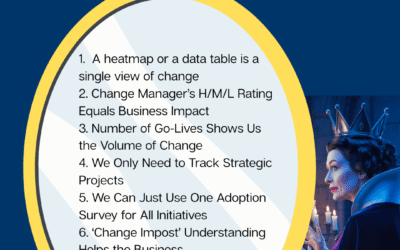- Set up a simple, business-led change governance
Instead of a myriad of project-based governance bodies, establish a divisional business body focused on managing change impacts on people and customers. This may be embedded into an existing monthly divisional leadership meeting. In this governance meeting, the focus is on:
- Reviewing the data and trends of change impacts (linking with other initiative data such as benefits and scheduling)
- Identifying any risks regarding the pace and the ‘amount’ of change
- Identifying opportunities to link change activities with key strategic themes so that it is easier for people to digest and absorb the change
- Identify opportunities to integrate roll-out activities such as training and workshops as appropriate
- Decision-making on the prioritization of change releases
- Monitor the feedback from impacted groups on the effectiveness of change delivery
This is not to say that project-based governance is not required. Business involvement is critical in project governance. However, a key focus should be placed on understanding the overall picture first and what the business is going to go through. From this clarity, it will then be easier to see how each initiative fits into the overall picture and if there are rollout considerations.
With clear change impact data, discussions will also be more swift, focused on more strategic conversations vs. gut feel and individual preferences. In this way, change is also being positioned as much more rigorous, data-driven, and scientific, versus fluffy, undefined, or worse, unimportant.
- Embed change impact management into the operating rhythm
One way to improve change capability in an organization is to focus operations on change and implementation, versus viewing change management as a separate piece of work done by Change Managers. This involves:
- Build the framework for initiative drivers to define and articulate change impacts, and own the update of initiative data in a central repository. When all initiative owners regularly update the data on change impacts, all stakeholders benefit. Initiative drivers are able to see what else is impacting the business and how to avoid any implementation bottlenecks. On the other hand, the business is able to better see the total picture.
- Build agreement within the organization to create one integrated picture of change impacts, irrespective of whether a change initiative is deemed as a project, program, or a business-as-usual activity. To do this, we need to adopt the perspective of the user impacted. Changes for them could include everything ranging from policy changes, technology changes, process changes, restructuring, marketing campaigns, and product changes.
- Build the management of change impacts into the roles and responsibilities of Operations. This includes a) considering change impacts in the process of resource planning, b) the ‘air traffic control’ of landing initiatives and their impacts, c) ensuring the impacted groups are ready and engaged) that the business has demonstrated the ownership and capability to adopt the change, e) managers accountable of driving the behavior embedment and monitoring of performance are clear.
- The change impact data should be open for anyone to access and understand. This would then put the onus on everyone to own and drive change. The frontline should also be able to look at the plan and understand the nature of the impacts on them. This will add significant value within an environment of concurrent multiple changes.
- Organizations should start with one division to test this model. Eventually, roll this out to other divisions. Once the whole organization has adopted this, an enterprise-level governance body may then be formed to promote cross-functional conversations in managing the ‘air traffic control’ and landing of initiatives. The quality of this conversation will also then be a key precursor to maximizing the benefit realization of initiatives
Check out our infographic on how to better manage a change portfolio.
- Quantify change impacts
One of the core problems faced by companies is how to quantify change impacts and make them more tangible, easier to visualize, measure and manage.
Change impacts may be quantified in the following way:
- The level of change. This denotes the intensity of the change impact. A Likert scale may be used to define and illustrate the different levels. For example, Level 1 could be minimal impacts, requiring the user only to attend a few meetings and read a few emails. However, at the highest level, the impact could be defined as significant, requiring role changes, in-depth training, and a new way of operating.
- The type of change. Different categories of change may be listed, including technology changes, policy changes, marketing changes, product changes, etc.
- Timing of change. This refers to the timing at which a change impact will occur. The impact may be different for different groups of stakeholders.
- The scale of the impact. This denotes the number of employees impacted as an estimate.
- Parts of the business impact. This refers to which parts of the business are impacted by this particular change impact.
- Change activity. This includes various change activities associated with the change impact, including training, workshops, formal communications, etc.
From the information provided, the analysis may then be undertaken, looking at the loading of change, whether there is any potential change clash from a timing perspective, whether there is behavior consistency across initiatives rolled out, and whether the initiatives overall are driving the organization’s strategy forward.
Moreover, with sufficient historical data, the company may then be able to correlate the impact of the ‘amount’ of change on business performance. From this, the change impact data may then be used to even ‘predict’ future business performance. Such is the power of quantifying change impact.
- Clarify customer impacts to manage customer experience
A significant number of companies are now jumping on the bandwagon of focusing on customer experience. This is because other value levers such as cost and efficiency are almost maxed out and there are few additional efficiencies that can be achieved there.
To truly manage customer experience one needs to start by understanding the total picture of what the company is planning to change for a particular group of customers. This includes:
- Customer change impact data, such as change type, timing, scale, and level of change (similar to those for employees)
- Customer type – this could be customer segments or other categorizations of customer groups
- A positive or negative change from the customer’s perspective
- Does the customer care about this change? How important is this change for the customer? It is critical to assess this from the customer’s lens, vs. the company’s lens?
After collecting these data, a customer’s experience may then be mapped out from the perspective of change impacts on their experience. Is there a number of legislative initiatives that will create a negative customer experience? Is there too much change planned? What would be the optimal ‘change loading’ for customers? The customer impact data enables valuable discussions and decisions
Check out our ultimate guide to change portfolio management.
- Leverage technology solutions
For smaller organizations managing change initiatives, spreadsheets may suffice. However, for large organizations managing a large portfolio of changes, spreadsheets may not be sufficient.
Technology solutions now enable both drivers and receivers of the change to access impact information any time and anywhere. This promotes collaboration and effective conversations. Companies will not need to rely on an army of analysts to constantly collect and verify the data, since the data is coming straight from ‘the source’. Reporting efforts are also optmized by having standard, automated reporting, generated at any time required.
Technology solutions are also great for agile-focused organizations where there is always a series of constant and iterative changes, and where change impact information could change rapidly from week to week. Access to accurate and timely data is even more critical.
Stakeholders across the company are also able to see, in real-time, the change impacts being planned. From this, meaningful conversations may be had in terms of the level and nature of change impacts from different stakeholder perspectives. For example, does the business share the same agreement of change impact as the program? This creates transparency and shared accountability in the ownership of change outcomes.
- Use data-based feedback to improve change capability
In implementing a data-based model of managing change impacts organizations will experience an uplift in change capability. How?
After a division reviews the feedback from stakeholders after initiatives get rolled out, referencing indicated ‘amount’ of change planned, this reference ‘amount’ then becomes a yardstick for answering ‘how much is too much change’.
Moreover, with regular routines and reviews over time, the yardstick of change loading can then aid future decision making on 1) the optimal change impact loading for the business, 2) readiness activities required to better manage across changes, 3) prioritization required, and 4) potential for synchronization across initiatives (e.g. communication or training efforts).
In this way, the business division learns to determine how best to utilize change impact data to prepare for changes, avoid change fatigue, and to maximize adoption. The outcome of this is testing with ‘tactics’ of managing the changing load, and improved business performance. With open data sharing, there is also an opportunity for cross-divisional learning to pick up tips from each other on how to manage multiple changes and still deliver operational performance.
Click here to download our infographic on How to Better Manage a Change Portfolio.






